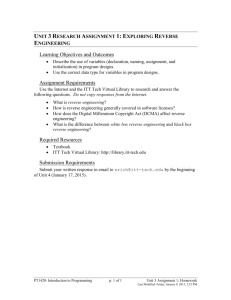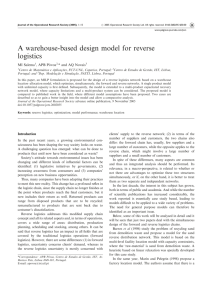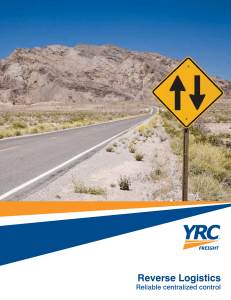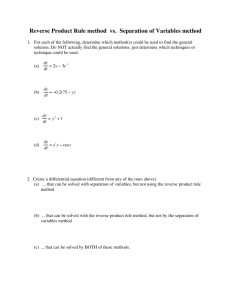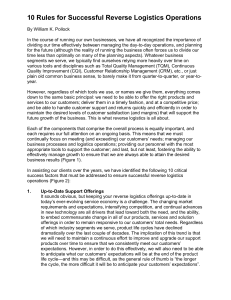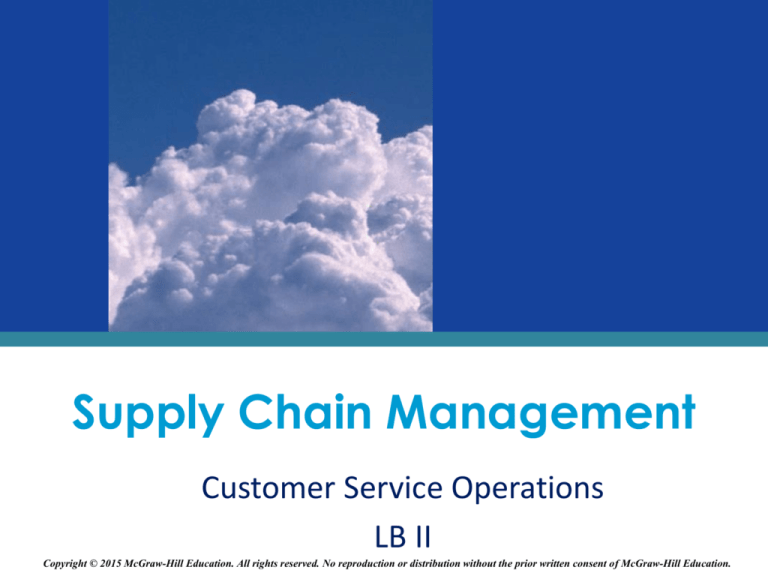
Supply Chain Management
Customer Service Operations
LB II
Copyright © 2015 McGraw-Hill Education. All rights reserved. No reproduction or distribution without the prior written consent of McGraw-Hill Education.
Objectives
• Returns and Reverse Logistics
• Encompasses Reverse Logistics
• Why are reverse logistics important
• Reasons for reverse logistics
• Key metrics used in customer
returns
LO1
1-2
Definition
• Reverse Logistics is the process of planning,
implementing, and controlling the efficient,
cost effective flow of raw materials, inprocess inventory, finished goods and related
information from the point of consumption
to the point of origin for the purpose of
recapturing value of proper disposal
• Disposition of returned items include
repair or replacement of products returned
LO1
1-3
Defective or Unwanted Products
• Reverse logistics has to do with the
return of products in the supply chain
• Reverse Logistics could include:
• Shipping
• Testing
• Repairing
• Recycling
• Disposal
LO1
1-4
Forward & Reverse Flow of Goods
• Historically, Forward flow has received the
most attention and is important for customer
service, revenues and cash flow.
• Reverse flow: Historically viewed by some
firms as “waste” and not adding value for
customers.
• Today, many firms see Reverse Flow as a
potential area of added value
LO1
1-5
Reverse Flow Logistics
•
•
•
•
LO1
Marginal benefit
Marginal cost
Marginal means “extra”
Comparison between marginal benefit and
marginal cost
1-6
Importance of Reverse Flow
• Returns Management or Reverse
Logistics can decrease costs and improve
customer relationships
• Product returns:
• Can be costly
• The procedure can detract from a
customer’s experience
LO2
1-7
Importance of Reverse Flow
• Product returns can:
• Reduce net revenues
• Increase inventory costs
• Increase packaging costs
• Increase customer
service/processing costs
LO3
1-8
Importance of Reverse Flow
• Defective Products can:
• Lead to negative reputation
• Cause future sales to decline
• Reverse logistics become more
important when sourcing globally
due to greater distances and time
involved
LO3
1-9
Importance of reverse flow
• Recent focus on reverse flow
results from the increased need
for reverse flows and for
managing customer returns
efficiently and effectively as a
distinct process.
LO4
1-10
Increased Need for Reverse Flow
• Contributing Factors include:
• Increased Internet Sales
• Many companies now allow
customers to return goods they
are dissatisfied with
• Many companies now have
exchange programs
LO5
1-11
Keys to Productive Flow
• Ensure Coordination
• Proactive “put-way” process to
make way for other deliverables
and make product availability in
the storage areas for customer
orders
LO5
1-12
Reasons for Returns
•
•
•
•
•
•
Failed products are defective or damaged
Products are unwanted
Obsolete or near their “shelf life”
Overstock or unsold products from retailers
Recalled due to quality and/or safety defects
Needs repair and returned into stock in a
distribution center and/or to the customer
• Parts that can be refurbished or sold
LO6 • Scrap that can be recovered and reused
1-13
Overall Flows of Returned
Products Include
• Re-inventory for resale
• Repair/refurbish for return to
customer or disposal
LO6
1-14
The Customer Return Process
• The return process is an important part of the
various functions that typically occur in a
warehouse
• The return process include:
• Product repair and return to the customer
• Placing material back into stock
• Refurbishing for resale
LO7
1-15
Customer Return of the Product
• When the return process is difficult, time
consuming, or confusing, the business may
loose the customer
• To make the return process easier, companies
provide:
• Return label which includes customer and
product information to:
• Speed up the process
• Trigger replacement or refund upon receipt
1-16
Warehousing Operations
• Organized warehouse speeds up
the process
• Provide specific location for
returns processing
1-17
Refund, Restock, Refurbish
• First step is to inspect the item
• Based on the return policy, a refund or
replacement is sent to the customer
• If item can be repaired or resold, appropriate
steps are taken to repair and resell
• Third-party logistics firms often refurbish
products
• “Cosmetic” imperfections can be repaired
and resold at a lower price
1-18
Recycling
• Different countries have different rules
and regulations regarding logistics that
impact the environment
• Many firms now offer a recycling
program for items such as:
• Batteries
• Goods with toxic elements
1-19
Returns Management
• Specialized systems support the returns
process to efficiently manage inspection
and disbursal decisions such as:
• Return the product as is to storage
• Repair and return to storage
• Repair and return back to customer
• Scrap the product
1-20
Stages in the Customer Return
Process
• Stages within a distribution center
• 1. Receipt: Returned and received
• 2. Sort and stage: Sorted based on
nature of return and likely distribution
• 3. Processing & Analysis: Data input
and customer credit
• 4. Disposition Activities: Include
destroy, repair, replace in stock
1-21
After Sale Warranty Process
• An integral part of the warranty process is to
manage the after sale warranty process
which include:
• Inspection
• Sorting
• Predetermined disposition (repair, scrap,
returns for warranty credit)
• Third-party logistics sometimes handle some
or all of the procedures
1-22
RMA’s
• Return Material Authorization Forms
(RMA’s)are used in the return process
• It is used to authorize a replacement or
refund of the product
• The number is included in the return
package to authorize refund or
replacement
• This process is automated for some firms
1-23
Industry Differences and Good
Practice In Customer Returns
• Examples:
• Fashion Industry – Returns are common
• Product can be placed right back into stock
• Pharmaceutical Industry – Strict rules
apply regarding batch and lot control
• Age of product and “sell by” dates are important
nature of return and likely distribution
• Returns are often classified as “waste”
1-24
Good Practices In Customer
Returns
•
•
•
•
•
•
•
Avoiding Returns
Reducing Cycle Times
Information Systems and Technology
Organization for returns
Layout
Asset Recovery
Effective and Efficient Returns Processes
and Procedures
1-25
Key Metrics Used In Customer
Returns Functions
• Length of time taken to return the product
• Amount and value of product reclaimed
and resold
• Percentage of material recycled
• Waste
• Percentage of cost recovered
• Per return / item handling cost
1-26



